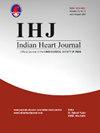药物涂层球囊在冠状动脉小血管和大血管新发病变中的疗效和长期疗效。
IF 1.8
Q3 CARDIAC & CARDIOVASCULAR SYSTEMS
引用次数: 0
摘要
目的:药物洗脱支架(DES)长期抗血小板治疗可导致支架内再狭窄和高出血风险。药物包被球囊(Drug-coated balloon, DCB)是一种不需要在血管壁上植入金属就能输送抗增殖药物的技术。我们的目的是比较其在大血管冠状动脉疾病(LvCAD)和小血管冠状动脉疾病(SvCAD)中的可行性。方法:237例冠状动脉新发病变患者采用dcb治疗,根据参考血管直径3mm分为SvCAD组和LvCAD组。主要终点是病变内晚期管腔损失(LLL)。次要终点包括复合主要心脏不良事件(MACE)、心脏性死亡、非致死性心肌梗死(MI)、靶病变血运重建术(TLR)、靶血管血运重建术(TVR)和血管血栓形成。结果:LvCAD组瞬时最小管径(3.06±0.25 vs 2.33±0.21 mm, p=0.001)和随访最小管径(3.13±0.25 vs 2.41±0.21 mm, p=0.001)和急性增益(1.92±0.29 vs 1.5±0.26 mm, p=0.04)均显著高于LvCAD组。病灶内LLL为阴性,差异无统计学意义(- 0.07±0.02 mm vs - 0.06±0.04 mm, p=0.69)。不良临床事件的发生率无统计学意义,复合MACE为6.5% vs 10.5% (p=0.27),心源性死亡为0.8% vs 0.9% (p=0.96),非致死性MI为4.9% vs.7% (p=0.49), TLR为4.1% vs. 6.1% (p=0.47), TVR为2.4% vs. 3.5% (p=0.63),血管血栓形成为1.6% vs. 2.6% (p=0.59)。结论:仅dcb治疗LvCAD有效,与SvCAD疗效相当。本文章由计算机程序翻译,如有差异,请以英文原文为准。
Efficacy and long-term outcomes of drug coated balloon in de novo lesions of small versus large coronary vessels
Objective
Drug eluting stent (DES) could result in both in-stent restenosis and high bleeding risk due to long-term anti-platelet therapy. Drug-coated balloon (DCB) delivers anti-proliferative drugs without implanting metal into vascular wall. Our aim was to investigate its feasibility in large vessel coronary artery disease (LvCAD), compared to small vessel coronary artery disease (SvCAD).
Methods
This study enrolled 237 patients with de novo coronary lesions treated with DCB-only strategy and categorized according to the reference vessel diameter of 3 mm into SvCAD and LvCAD groups. The primary endpoint was in-lesion late lumen loss (LLL). The secondary endpoints included composite major adverse cardiac events (MACE), cardiac death, non-fatal myocardial infarction (MI), target lesion revascularization (TLR), target vessel revascularization (TVR), and vessel thrombosis.
Results
The immediate (3.06 ± 0.25 vs. 2.33 ± 0.21 mm, p = 0.001) and follow up minimal lumen diameter (3.13 ± 0.25 vs. 2.41 ± 0.21 mm, p = 0.001) and acute gain (1.92 ± 0.29 vs. 1.5 ± 0.26 mm, p = 0.04) were significantly higher in LvCAD group. In-lesion LLL was negative without significant difference (-0.07 ± 0.02 vs. - 0.06 ± 0.04 mm, p = 0.69). The incidence of adverse clinical events was not statistically significant accounting for 6.5 % vs. 10.5 % for composite MACE (p = 0.27), 0.8 % vs. 0.9 % for cardiac death (p = 0.96), 4.9 % vs.7 % for non-fatal MI (p = 0.49), 4.1 % vs. 6.1 % for TLR (p = 0.47), 2.4 % vs. 3.5 % for TVR (p = 0.63) and 1.6 % vs. 2.6 % for vessel thrombosis (p = 0.59).
Conclusion
DCB-only strategy is effective in treating LvCAD with comparable outcomes to SvCAD.
求助全文
通过发布文献求助,成功后即可免费获取论文全文。
去求助
来源期刊

Indian heart journal
CARDIAC & CARDIOVASCULAR SYSTEMS-
CiteScore
2.60
自引率
6.70%
发文量
82
审稿时长
52 days
期刊介绍:
Indian Heart Journal (IHJ) is the official peer-reviewed open access journal of Cardiological Society of India and accepts articles for publication from across the globe. The journal aims to promote high quality research and serve as a platform for dissemination of scientific information in cardiology with particular focus on South Asia. The journal aims to publish cutting edge research in the field of clinical as well as non-clinical cardiology - including cardiovascular medicine and surgery. Some of the topics covered are Heart Failure, Coronary Artery Disease, Hypertension, Interventional Cardiology, Cardiac Surgery, Valvular Heart Disease, Pulmonary Hypertension and Infective Endocarditis. IHJ open access invites original research articles, research briefs, perspective, case reports, case vignette, cardiovascular images, cardiovascular graphics, research letters, correspondence, reader forum, and interesting photographs, for publication. IHJ open access also publishes theme-based special issues and abstracts of papers presented at the annual conference of the Cardiological Society of India.
 求助内容:
求助内容: 应助结果提醒方式:
应助结果提醒方式:


